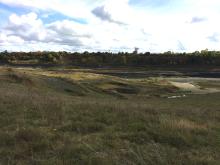As winter approaches, 150,000 honey bees are preparing to colonise in six hives recently located at
The 60-hectare quarry site, with Special Area of Conservation status, provides a perfect environment for the bees with its extensive beech woodland and wide variety of flora and fauna in the woods and on the restored rock benches.
The siting of these valuable hives will help increase the biodiversity of the quarry site and local area by enhancing plant and wildlife as well as helping, in a small way, to arrest the recent decline of the bee population in the UK.
The hives belong to and are managed by local resident Elaine Spence who originally was trying to find a good location for just one hive, but found somewhere for all six.
“Pollinating insects, including honey bees are vital for our natural environment and its biodiversity. It is also estimated they pollinate up to a third of all our food and pollinators, worth £430million (€500million) per year to British agriculture. Taffs Well quarry is an excellent site for the hives as it has plenty of space with available ‘food’ for the bees,” she said.
In 2010 Cemex UK, in conjunction with the RSPB (






